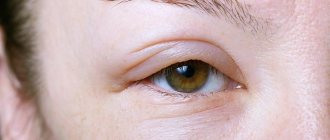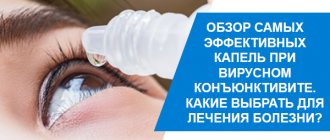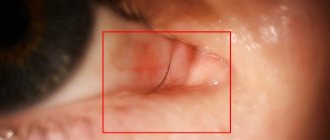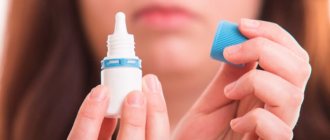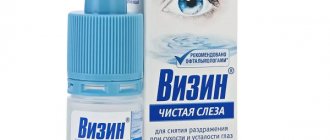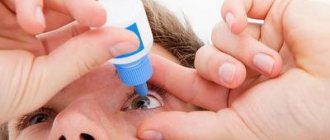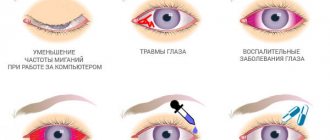Most often, hormonal eye drops are prescribed in complex cases when most other medications have not been able to help solve the problem.
Among all eye drops, hormonal drugs occupy a special place. Their composition and principle of action differs from most other ophthalmic drugs.
Local use of steroids in ophthalmology minimizes their effect on the body as a whole, but has a high therapeutic local effect.
Hormonal drops or steroids are drugs that can relieve severe inflammation. At the same time, they act at the cellular level, which most other drugs cannot do. The main active ingredients of these drugs are glucocorticosteroids (hormones), created synthetically. It is completely identical to the natural ones produced by the human thyroid gland.
Another important difference between these drugs is their ability to penetrate all structures of the eye, including the lens. And this significantly increases their therapeutic capabilities.
Steroids can be in a sterile solution alone or combined with NSAIDs (antibiotics). In the first case it is only a hormonal drug, and in the second it is a combined drug.
They are used only after a doctor’s prescription; independent use can cause more harm than good.
The most common use of hormonal drugs is indicated in the following cases.
- For extensive autoimmune diseases, severe allergic manifestations that are not controlled by antihistamines.
- For complex, combined injuries and burns of the eye to prevent the proliferation of connective tissues and the formation of scars.
- During surgery for corneal transplantation. Hormones prevent the rejection of donor tissue.
Steroid drugs in ophthalmology
The development of ophthalmic therapy methods is constant and rapid.
In addition to the significant modernization of eye surgery, there has also been considerable progress in the drug treatment methods used by ophthalmologists. Modern medicine uses a huge number of drugs, one of which is steroids. Despite their high effectiveness, these medications are used with great caution due to the presence of a considerable number of side effects.
In today’s material and the section of the same name on our resource, we will talk in detail about the essence and rules of using steroid drugs for the treatment of eye pathologies. Interesting? Then be sure to read the article below to the end.
A few words about the essence of steroid medications
Steroid drugs used in ophthalmology are mostly aimed at providing local effects.
These medications are produced on the basis of synthetic glucocorticoids, which, when they come into contact with the affected eye tissue, create the effect of cortisol (stress hormone).
The latter substance, increasing blood sugar levels due to gluconeogenesis, neutralizes inflammation and improves local metabolism.
The basic purpose of steroids in the treatment of eye diseases is the presence of an inflammatory process, which is successfully suppressed through their use. In most clinical cases, “steroids” are not the basis of therapy, but represent one of the links in a whole complex of therapeutic measures.
However, it is important to note that steroid drugs are one of the key links in the treatment of many ophthalmological pathologies, as they improve the effect of other medications used and speed up the patient’s recovery process.
As mentioned above, steroid drugs have a lot of side effects, which is definitely a disadvantage of these drugs.
Often, ophthalmologists think for a long time - should they prescribe “steroids” to a particular patient, or is it better not to risk it by choosing other types of medications? When making a final decision, any doctor will definitely analyze and compare the potential benefits of taking steroid drugs with the risks of side effects.
This approach is especially relevant if long-term and systematic use of anti-inflammatory drugs is necessary. One of the main side effects of ophthalmic “steroids” is an increase in intraocular pressure, which can be observed in both patients with glaucoma and healthy people.
According to official statistics, approximately 10 percent of patients treating their eye ailments with steroid drugs experience this side effect. It is worth noting that blood pressure may increase both during therapy and after its completion (after 1-2 weeks).
A less frequent, but also possible, side effect should be considered a weakening of the local immunity of the eyes, which significantly increases the risk of contracting infectious diseases.
Types of steroid drugs and their use
It was previously noted that steroid drugs in ophthalmology are used in the form of local agents. To be more precise, the form of drugs can be of two types:
In turn, each type of steroid is divided into “soft” and “hard”. The first group of medications has a rather mild immunosuppressive effect on the eyes, as a result of which the risks of side effects are very, very small, and therefore they can be treated for a long period of time using tactics with a reduced dosage.
“Hard steroids” are more aggressive in terms of their action, however, the effectiveness of their use is noticeably higher. In the absence of specific contraindications in patients, these drugs are used to treat severe inflammation.
Unambiguous prohibitions on the use of “hard” steroid drugs are such ailments as:
- inflammatory processes of the cornea and conjunctiva of viral etiology;
- ocular tuberculosis;
- glaucoma;
- increased intraocular pressure;
- fungal eye pathologies;
- purulent processes in the eyeballs;
- allergic reaction to medications.
In ophthalmological practice, a treatment regimen with “steroids” is widely practiced, in which strong drugs are used in the first 1-2 weeks of therapy, gradually being replaced with milder agents.
This approach is the most rational, as it allows you to maintain the therapeutic effect and reduce the risks of complications and side effects to a minimum. In any case, no matter how and with whatever help steroid therapy for eye diseases is carried out, observation by a professional ophthalmologist during this period is mandatory, which should not be forgotten.
Review of hormonal drugs
Maxidex - eye drops containing dexamethasone 0.1%. The drug is prescribed for allergic reactions of the conjunctiva and inflammation of a non-bacterial nature. Like all corticosteroids, it cannot be used against the background of smallpox, herpes, or actinomycosis.
Side effects are typical for this group of drugs and require careful monitoring of IOP. Dexamethasone increases intraocular pressure the most among the group of ophthalmic corticosteroids.
It should be remembered that drops cannot be prescribed to yourself and should not be used before visiting a doctor. The anti-inflammatory effect of the drops masks some symptoms of acute bacterial infections, which affects the correct diagnosis.
Also, ophthalmic corticosteroids should not be used simultaneously with non-steroidal anti-inflammatory drugs, since this combination delays the healing of wounds on the cornea and leads to its thinning and the formation of ulcers.
GCS drugs are prescribed to pregnant women only for essential indications. Although there is no data on the penetration of the drug into breast milk, you should refrain from feeding the baby during treatment. There is no evidence of significant effects in children.
Treatment begins with 1-2 drops every hour, then the dosage is gradually reduced by reducing the frequency of administration - every 4 hours, and then to once a day.
Trade names: eye drops Dexamethasone, Dexapos, Medexol, Oftan Dexamethasone, Farmadex
Flarex is an eye drop that has pronounced anti-inflammatory, anti-edematous and anti-allergic activity. They are used to prevent collagen deposition and scar formation, as well as for persistent non-purulent and allergic conjunctivitis, keratoconjunctivitis, blepharitis, scleritis, optic neuritis, inflammation after eye trauma and surgical interventions. Drops based on fluorometholone contribute least to increasing IOP.
You need to instill the drug 1-2 drops two to four times a day. Use in conditions where the integrity of the cornea is compromised is fraught with the development of a fungal or bacterial infection.
The drug can be prescribed to pregnant women and children only if the expected positive effect prevails over possible adverse reactions - an increase in IOP, the development of cataracts.
The drops are produced in the form of a suspension, so before use the bottle must be shaken several times to form a homogeneous solution.
Trade names of analogues: Efflumidex, Fluorometholone suspension
Prednisolone ophthalmic suspension 0.5% – steroid ophthalmic drops. Used only topically to relieve symptoms of inflammation caused by allergies, injury or surgery.
Drops should not be used if you are allergic to prednisolone or other steroids, or if you are allergic to certain types of ophthalmic infections (viral, fungal or bacterial).
These drops should not be used on contact lenses because this medication contains a preservative that can be absorbed by soft contact lenses and cause discoloration. Wait at least 15 minutes after using prednisolone before inserting contact lenses.
If after two days of using Prednisolone the swelling of the eyes does not decrease, you should immediately consult a doctor.
Use this medicine only according to the schedule and in the amounts that your doctor determines for you, since the withdrawal of the drops should occur very smoothly.
As with all corticosteroids, there is no reliable data on safety for Prednisolone in pregnant, lactating women or children
This drug is found on the domestic market under the name Prednisolone suspension, but there are also its imported analogues: Inflamase Forte, Omnipred, Prednisol.
Prenacid is an ophthalmic drop with a local hormonal component. They have proven themselves in the treatment of inflammatory diseases such as allergic reactions, scaly blepharitis, thermal or chemical damage to the cornea.
Side effects are typical for all GCS; intraocular pressure may increase after two weeks of systematic use. Drops should not be used for tuberculosis, viral or fungal diseases of the cornea, as well as for its abrasions and possible thinning.
Drops are instilled every 6–8 hours, 1–2 pieces. into the sore eye
Alrex or Lotemaks eye drops contain topical corticosteroids and are intended to eliminate the symptoms of allergic spring conjunctivitis.
Combinations
Mono preparations of glucocorticosteroids are used mainly to suppress immunological inflammation, relieve itching, swelling, and redness. But often after surgical procedures, prevention of bacterial infection of the eyes is also required. Therefore, there is a large group of drugs that are stable combinations of GCS with antimicrobial drugs.
Combined hormonal drops with antibiotics
Advantages of combination drugs:
- there is no need to wait a pause between applying several types of drops to the eye;
- you can be sure that there will be no unexpected chemical or therapeutic interactions between drugs;
- Also, in one drug you can get well-selected and proven doses of several drugs.
Combinations with betamethasone: drops that can be instilled into the eyes and ears - Garazon. They contain the antibiotic gentamicin. The frequency of administration is 1–2 potassium up to four times a day.
Combination with dexamethasone: Sofradex drops, which exhibit their antibacterial activity thanks to the antibiotics neomycin and gramicidin. To maintain an overwhelming concentration of antibacterial components, drops should be instilled frequently - up to six times a day.
Dexamethasone and neomycin are also successfully combined with another antibiotic, polymyxin B, which is active against most pathogens of ophthalmic infections. This composition is contained in the drug Maxitrol, Neladex. In the acute period of the disease, they can be used every hour, gradually reducing the frequency of administration to four times a day.
One of the most effective and safe antibiotics of the aminoglycoside group, Tobramycin, in combination with dexamethasone, is included in the eye drops Medetrom, Dexatobrom, Tobradex. They can be used even in children older than 12 months.
There is also the option of combining dexamethasone with neomycin in Dexon drops. Due to their activity, drops can be used both in ophthalmology and for the treatment of diseases of the external ear.
Combinations with hydrocortisone – Gikomycin-Teva. These drops contain dexamethasone and neomycin. Start taking 2 drops into the affected eye every 2 hours, and then switch to four instillations during the day.
Combinations with prednisolone - Loxtra drops. They contain the fluoroquinolone antibiotic ofloxacin and the vasoconstrictor component – tetrahydrozoline hydrochloride. This composition allows you to cope well with swelling and inflammation that arise against the background of a bacterial infection.
Important! It should be remembered that drops that combine GCS with antibiotics cannot be used for viral eye diseases or a fungal infection. The likelihood of developing side effects is associated with the possible action of each of the components of the composition, be it a steroid or an antibiotic.
https://www.youtube.com/watch?v=yzr7BBwsF80
Since hormonal eye drops have serious side effects, they should only be prescribed by a doctor, taking into account existing pathologies and concomitant conditions.
Rubric “Steroid drugs in ophthalmology” - what is its benefit for readers
Despite the ambiguity in terms of use, steroid drugs are still actively used by ophthalmologists to treat patients.
Among the users of our resource, dedicated specifically to eye pathologies, there were many people interested in this group of medications.
Considering this state of affairs, the site team decided to devote not 1-2 articles to ophthalmic “steroids”, but a section that fully reveals their essence. Its name, by the way, is appropriate - “Steroid drugs in ophthalmology.”
The creation of articles in this section of the site is done not just by masters of the pen, but also by several highly qualified practicing ophthalmologists. Working in such symbiosis, specialists in their fields present extremely reliable and useful material for readers.
In particular, on the pages of the section anyone can find answers to questions like:
- How to take steroid drugs for various ophthalmic ailments?
- What to do if side effects occur?
- Are they dangerous?
- Which means are most preferable to choose?
- Is self-medication with steroids allowed?
In general, everyone who wants to consider the topic summarized today in more detail is simply obliged to familiarize themselves with all the material presented in the section “Steroid drugs in ophthalmology.” We assure you that the available articles will be as useful as possible for everyone and will be able to provide answers to your questions.
Using eye drops
Lubricating eye drops
help replace natural moisture for the eye when the latter cannot produce this fluid independently and in sufficient volume. As a result, the drops reduce dryness and irritation of the eyes, promoting comfortable vision.
Artificial tears in the damaged eye
» also promote surface healing, reduce the feeling of scratches on the surface and wash away any residual contaminants or harmful particles. They prevent further damage by keeping the eyes naturally lubricated.
Such drops have different composition and viscosity. Some may contain bicarbonate ions, while others have no preservatives, which should be preferred.
Antiallergic drops
relieve itching and burning of the eyes, which are so common with allergies. The use of such medicinal eye drops reduces the likelihood of systemic side effects, for example: when taking certain groups of drugs that have a sedative effect.
Complications and risks - eye drops
Each type of drug has its own risks, including eye drops
:
Steroid and antibiotic eye drops
are commonly used to treat eye infections and to prevent bacterial infection after eye surgery. They should be used as long as prescribed - otherwise, there is a risk of weakening natural immunity.
Drops for glaucoma
designed to reduce fluid inside the eyes and promote its drainage - lowering intraocular pressure. Some common types include prostaglandins, alpha blockers, and carbonic anhydrase inhibitors. They should only be used as prescribed to protect your vision - there are quite a few side effects on vision.
Antiallergic eye drops
often contain antihistamines or nonsteroidal anti-inflammatory drugs (NSAIDs) to suppress the release of inflammatory substances from eye cells. They also “dilute” the concentration of the allergen. But they can be addictive if used inappropriately. Remember, these drugs are used only to treat allergies.
Muscular eye drops
, also known as “dilating” drops, are used to allow the ophthalmologist to see the inside of the eye through the pupil. Subsequently, the patient may suffer from mild intolerance, blurred vision and watery eyes for a short period of time. During this period, you should avoid driving a vehicle on your own.
Drops that reduce redness
, contain decongestants that constrict the blood vessels in the conjunctiva and thus make the eye whiter. However, with continued use, the blood vessels in the eyes actually become dilated than before, which is called the "re-congestion" effect. They should only be used for a couple of days maximum.
Drops that reduce redness may also interfere with the diagnosis and treatment of a more serious problem, which ultimately leads to deterioration of vision.
Features of the drugs
All types of eye drops have a number of common properties. An important feature of such agents is the ability to quickly penetrate through the conjunctiva, the outer shell of the eye, into the deeper parts of the eyeball.
This effect is achieved thanks to special technologies used in the production process.
Each drug has its own characteristics: it contains its own active substance, is used for a specific purpose and is included in one or another group of eye drops.
- used to combat various types of infections. This is the largest pharmacological group, which, in turn, is divided into several subgroups. There are antibacterial, antiviral and antifungal eye drops, and by the nature of the active substance - antibiotics, chemotherapeutic drugs and antiseptics.
- Anti-inflammatory eye drops are intended to treat inflammatory lesions. the organ of vision and its appendages of a non-infectious nature. This group, in turn, is divided into steroidal anti-inflammatory drops (hormonal anti-inflammatory drops) and non-steroidal anti-inflammatory drops. Both of them can consist of several components that expand their spectrum of action. (For example ).
Average price: 100 rubles.
- , are divided into 2 large groups: medications that improve the outflow of intraocular fluid, and medications that reduce its production. For example, they will be effective.
- intended for the treatment and prevention of allergic reactions. The principle of action of these drugs is to suppress the initiation of the inflammatory reaction at the cellular level or to block histamine receptors.
- Local vasoconstrictor drugs relieve symptoms of allergic inflammation, such as swelling and hyperemia, and significantly reduce pain.
- , slow down its development.
- Moisturizing eye drops, or “,” are intended to prevent dry eye syndrome.
- Diagnostic eye drops are used during surgical procedures.
General risks of using eye drops
Preservatives and thickeners in eye drops may cause irritation
eyes if used for too long. This is another reason why eye drops should not be used beyond the recommended period of use, unless it is just a saline solution. No more than four doses of any eye drops containing preservatives should be used in one day. For more frequent use, it is necessary to choose eye drops without preservatives.
When applying eye drops
, the container should not touch the eyes or other surface to avoid contamination of the tip and the spread of infection. The lid should also be tightly and carefully closed as soon as use is finished. Containers with loose rings or seals should not be used as the seal may get into the eye during use.
Even “artificial tears” can cause side effects
, such as short-term blurred vision immediately after use. Driving or operating machinery should be avoided until vision returns to normal.
Remember
also that any ingredient in eye drops can cause allergies or anaphylaxis. Therefore, initially test the drops on more protected surfaces, such as the skin of your hands.
If you need to use eye drops every day, it is wise to first visit an ophthalmologist
rather than continue self-medication.
Finally, no eye drop solution should be used for more than four months
after opening it, as there is likely fungal or bacterial contamination.
Thank you for reading us - we will be grateful if you give us a positive rating
and of course
subscribe
to our channel.
Rules of application
The specified dosage should be adhered to. You cannot change the dosage or interrupt treatment on your own, without the doctor’s permission. If the patient wears contact lenses, they must be removed before instillation. The lenses are reinserted 10 minutes after the procedure. Some drops must be stored in the refrigerator; you should understand this point by reading the instructions for the drug.
Before the procedure, you must thoroughly wash your hands, rinse your eyes and remove moisture from your eyelids with a dry towel. If the drops were stored in the refrigerator, then before instillation it is necessary to warm them to room temperature.
Drops should be instilled in a supine position or with your head thrown back. Taking the bottle, you need to turn it upside down, and with the other hand pull down the eyelid and look up. Then you should squeeze out the drop without touching the bottle with your eye, so that it falls into the space between the eyelid and the eyeball.
After completing the procedure, you need to close your eye and lightly massage the inner eyelid, but you should not squint your eyes or rub your eye as hard as you can.
In order for hormonal eye drops to bring noticeable results, you need to adhere to the rules for their use:
- The use of local drugs should not be stopped abruptly. Their dosage should be reduced gradually. Otherwise, there is a high probability of developing withdrawal syndrome. This will lead to a sudden increase in intraocular pressure parameters.
- It is strictly prohibited to use such substances for prophylaxis. They can be administered only in the case of a clearly established diagnosis.
- Therapy should begin with more gentle means. This category includes hydrocortisone. If the substance does not produce noticeable results, stronger agents can be used. This category includes prednisolone and dexamethasone.
- If there is a suspicion of a secondary bacterial infection, preference should be given to combined substances that contain antimicrobial components.
- It is better to avoid using contact lenses during therapy. In this case, it is worth switching to glasses.
- It is strictly forbidden to exceed the period of use of eye drops containing steroid hormones recommended by your doctor. This leads to adverse reactions. Children under 2 years of age are especially susceptible to unwanted symptoms.
- If you miss another dose of medication, you should take it as soon as possible. If the time for the next administration of the substance approaches, the missed dose is canceled. Subsequently, you need to follow the schedule established by the ophthalmologist.
- All products from this category must be kept out of the reach of children.
- It is recommended to store the composition in closed packaging. This should be done at room temperature. It is important to keep the product away from light sources and exposure to high temperatures. Also, the room should not be very humid.
When are they needed?
When an ophthalmologist finds out the reason that led to the unpleasant process, he recommends drops based on it. Eyes are very sensitive to external factors. The syndrome of “dryness” of the organ of vision is common. In the process, cracks appear, into which infection enters. Eye drops to relieve inflammation are prescribed if it was caused by the following factors:
- allergy;
- infection;
- mechanical damage;
- autoimmune diseases.
Symptoms of the inflammatory process in the organ of vision are: suppuration, redness of the eyelid, swelling, pain. Also, with this condition, the quality of vision may deteriorate. If your eye is inflamed, it is better to immediately consult an ophthalmologist, who will identify the cause and prescribe appropriate medications for treatment.
Types of medicines
Steroid
These drugs are similar in composition to hormonal anti-inflammatory drugs. They are prescribed for severe processes and after surgery on the organ of vision. With an antibiotic in their composition, they eliminate swelling and redness. They are also good antiseptics, as they kill germs. The drops contain hormones that are similar to human ones. This allows you to block the inflammation process at the cellular level. The medicine is contraindicated for use in children under 7 years of age.
It is not recommended to use steroid drops for a long time with inflamed eyelids, as the body quickly gets used to them and they become ineffective.
Against dryness
If the organ of vision constantly dries out, then medications are prescribed that artificially moisturize the cornea. The main active elements of these drugs are keratoprotectors. They produce a substance that replaces natural tears, thereby eliminating drying. Eye drops for dryness are prescribed by an ophthalmologist after identifying the cause of this condition.
Non-steroidal
Drops against inflammation of this type are used in the initial stages of the disease, when it is in a mild form. They effectively treat swelling and pain. The drugs slow down the flow of blood to the affected area, which helps relieve inflammation. Contraindicated in children under 3 years of age with closed-angle glaucoma. If this type of medication is dropped into the eye, a burning sensation is felt.
Combined
These eye drops for inflammation of the eyelids contain components that fight allergies and infectious microbes and relieve inflammation. They are prescribed if a person has inflamed eyelids, regardless of the cause of this condition. The drugs should be used only on the recommendation of an ophthalmologist, as side effects may occur.
Operating principle
Medicines in this category are classified as steroids. Their key task lies in eliminating severe inflammation and allergies. These drugs produce an effect at the cellular level, which cannot be said about other medications.
The main substances of these drugs are hormonal elements - glucocorticosteroids, which are obtained artificially. These components are complete analogues of hormones that are produced in the human body.
The main characteristic of such agents is the ability to penetrate deep into the structures of the visual organ, including the lens. Due to this, the therapeutic effect is significantly increased.
Although such products are highly effective, using them yourself is strictly prohibited. These medications have a number of side effects, so they can cause significant harm to health.
Anti-inflammatory eye drops: list of products for children and adults
There are many reasons for the development of inflammatory processes in the eyes or eyelids. Working at a monitor, frequently watching TV or using various gadgets becomes a factor in overstraining the visual organs, which leads to “dry eye” syndrome.
Various viral or allergic factors also contribute to discomfort, decreased visual acuity and other unpleasant nuances that require an immediate visit to an ophthalmologist. Eye drops for inflammation are the optimal method of local treatment, but in the huge range of products for this purpose, it is important to choose them correctly.
How to choose antibiotic eye drops
Inflammatory processes can be triggered by several factors:
- eyeball injuries;
- allergic reactions;
- viral and other infections;
- general diseases of the immune system, affecting the condition of the mucous membranes.
Drops for the eyes or eyelids are chosen strictly depending on the cause of inflammation, otherwise serious damage to the organs of vision can be caused and lead to a decrease in visual function.
Anti-inflammatory drugs of this spectrum are different in composition and purpose, and are divided into:
It is recommended to purchase eye drops only as prescribed by a doctor, as they have different effects. Thus, antibiotics help in the fight against bacterial infection, but for discomfort caused by dry mucous membranes, drops with a completely different composition, similar to natural tears, are used.
Find out how to choose eye drops for dry eyes here.
Symptoms that require immediate treatment - what to do if the eyes fester and water in adults.
Purpose
itching sensation, high permeability of blood vessels, redness of tissues, their swelling.
The production of antibodies and the number of circulating T- and B-lymphocytes, that is, factors of the immune response, are also inhibited. The use of hormonal drugs eliminates inflammation and reduces the likelihood of scar formation on the cornea. Depending on the severity of the disease, glucocorticoids can be used in the form of eye drops and ointments, creams, rarely tablets or injections into the retrobulbar space (to create a depot).
The most effective eye drops for inflammation and redness
Self-medication with antibacterial and steroid eye drops is unacceptable, because their formula contains an antibiotic and a hormone. The drug acts at the cellular level. Its frequent use causes addiction, and in the future the effect of treatment is significantly reduced. Prescribed for severe pathologies of the visual organs or in the period after ophthalmic surgery.
Good anti-inflammatory with corticosteroid
Among the most effective remedies with antibiotics and corticosteroids:
- Dexamethasone - also used for non-purulent conjunctivitis, keratitis, blepharitis and scleritis.
- Sofradex - instructions for eye drops are included;
- Maxitrol.
Non-steroidal
At the early stage of inflammation or in mild cases, non-steroidal drugs are prescribed. This:
- Diclofenac - can cause complications on the cornea or cause allergies.
- Tobradex;
- Indocollier;
- Diklo-F et al.
Combined against inflammation
The combined group contains both an anti-inflammatory component and an antibiotic (an anti-allergy component is also possible). Glucocorticosteroids are contraindicated in cases of increased intraocular pressure and defects of the mucous membrane and/or cornea. They are mostly used for bacterial infections. Popular:
For adults
Depending on the nature of the inflammation, the following may be prescribed for the treatment of adults: In case of infections, operations, or other causes of inflammation accompanied by severe pain:
- Diclofenac;
- Tetracaine;
- Oxybuprocaine, etc.
In case of an allergic nature of inflammatory reactions (to a specific animal protein, spreading to wool with saliva and other secretions, as well as to pollen, poplar fluff, eye cosmetics, etc.):
With fatigue and the first signs of progressive inflammation:
Before purchasing a particular drug, it is important to read the instructions for use, which provide information about adverse reactions, contraindications and restrictions on use. This will help avoid possible complications.
Instructions for using Potassium iodide eye drops are available here.
For children
Among patients of the pediatric age category, eye diseases are common, caused by viruses and infections that enter the mucous membrane along with dirt, etc. The phenomenon is very common, however, in each individual case, an examination by an ophthalmologist and the selection of appropriate drugs for treatment are necessary.
The best products available in the form of drops for children are:
- Floxal - practiced from the first days of life against conjunctivitis caused by bacteria. Instructions for Floxal eye drops.
- Levomycetin - have a wide spectrum of action, but can provoke allergic reactions.
- Kromhexal – suitable for children aged 6 years and older.
- Tobrex is an antibiotic that fights staphylococcus and streptococcus.
- Albucid - antibacterial eye drops, the action of which is directed against chlamydia and cocci. Prescribed to children from birth.
- Cortisone is a hormonal drug against allergies and inflammation.
- Interferon – suitable against viral conjunctivitis.
You cannot independently select a remedy against eye inflammation for children (especially newborns), because potential complications may be irreversible. Any drug that for some reason is not suitable for the patient can be replaced by an ophthalmologist with a drug of similar effect.
A list of eye ointments with antibiotics is provided at the link.
A drug for relieving swelling and inflammation of a non-infectious nature - Oftan Dexamethasone eye drops.
Indications
When prescribed correctly, steroid treatment is invaluable in ophthalmology, especially in the postoperative period, since largely thanks to hormonal drops it is possible to preserve implanted lenses and prevent excess formation of connective tissue and scarring during postoperative ocular inflammation or vitrectomy.
Hormonal drops are prescribed to eliminate inflammation after eye surgery
Ophthalmic hormonal drops are also used in the following cases:
- with anterior uveitis - inflammation of the choroid of the uveal tract: iritis, anterior cyclitis, iridocyclitis;
- severe blepharoconjunctivitis - as reserve drugs if non-steroidal anti-inflammatory drugs, antihistamines or mast cell inhibitors do not have the expected effect;
- keratitis - in combination with antiviral therapy for herpetic eye disease, with antibiotics for bacterial infection;
- diabetic macular edema;
- seasonal allergic conjunctivitis.
Other dosage forms of corticosteroids are used for diseases that require a different route of administration:
- creams and ointments (Hydrocortisone 0.5%, 1%) – for periocular eczema (skin disease around the eyes);
- injections – macular edema, secondary retinal occlusion in diabetic retinopathy, posterior uveitis;
- tablet forms - for scleritis, arteritis, posterior retinitis.
When used correctly, hormonal drops are highly effective. Most often they are discharged after operations. Thanks to such substances, it is possible to preserve artificial lenses and avoid the appearance of excess connective tissue and scars after the procedure.
In addition, hormonal eye drops are prescribed in the following situations:
- Anterior uveitis. This term refers to inflammatory damage to the lining of the vessels of the uveal tract. As a result, there is a risk of developing iritis, cyclitis, and iridocyclitis.
- Complex form of blepharoconjunctivitis. In this case, hormonal drops are reserve drugs. They are prescribed when non-steroidal drugs, antihistamines and mast cell inhibitors are ineffective.
- Keratitis. Hormones are usually combined with antiviral agents for herpetic lesions of the organ of vision. If a person has a bacterial infection, such drugs are combined with antibiotics.
- Seasonal allergic conjunctivitis.
- Diabetic macular edema.
The choice of type of medication depends on the diagnosis:
- Ointments - indicated for periocular eczema, which affects the skin around the eyes;
- Injections - indications for their implementation are macular edema, posterior uveitis, secondary retinal occlusion, which appears against the background of retinopathy of diabetic origin;
- Tablets - used for arteritis, scleritis, retinitis.
It is not recommended to use hormonal drops in the following situations:
- Bacterial eye pathologies;
- Fungal infections and viral diseases, including ocular herpes;
- Pregnancy and lactation;
- Glaucoma;
- Childhood;
- Erosive lesion of the cornea.
Key restrictions on the use of such funds include the following:
- Shingles;
- Diabetes;
- Bronchial asthma;
- Syphilis;
- Arterial hypertension;
- Tuberculosis.
Prices and reviews
The cost of anti-inflammatory eye drops in Russian pharmacies varies widely from 10 rubles to several hundred. It depends on the country of origin, ingredients, and region of purchase of the medicine.
| Name | price, rub. |
| Phloxal | 160-190 |
| Levomycetin | 10-18 |
| Tobrex | 168-196 |
| Sofradex | 269-338 |
| Diclofenac | 24-32 |
| Tobradex | 398-526 |
| Diklo-F | 131-181 |
Find out which eye drops to choose when wearing contact lenses here.
How to choose eye drops to improve vision is described in detail in the article.
After consulting with an ophthalmologist, patient reviews will help you make the right choice:
- Irina Grushina, Moscow : “My son (1 year and 11 months) has clogged his eyes with sand. They prescribed us the antibiotic Sofradex. The drops are universal, suitable for both eyes and ears. The doctor warned that it would sting, and it really did. But the symptoms disappeared completely after 3 days.”
- Lisa Grinko, Orsk : “I received a 2nd degree corneal burn, for which complex treatment was prescribed. Among other things, I used Thiotriazolin, the indications for it also include inflammation caused by fatigue and dry eyes, and I work as a designer and spend a lot of time in front of the monitor. Great product, it really helped me. I found only one drawback - they are stored a little, only 5 of them after opening, and then buy again.”
- Ruslan Potashov, Kirov : “Ordinary Levomycytin helped me. Cheap and effective."
To relieve inflammation of the eyes and eyelids, ophthalmic medications in the form of drops or ointments are used. Recommendations for treatment should be made by a specialist based on a visual examination, complaints, age of the patient and accompanying symptoms.
It is not advisable to self-medicate, because... an incorrectly selected drug can negatively affect visual acuity.
Before initial use, you must read the package insert, which contains useful information about the drug, incl. contraindications and adverse reactions.
The material presented is for informational purposes only and is not a guide to purchasing a particular drug. To diagnose the disease, determine the cause of inflammation and prescribe further treatment, consultation with a specialist is required.
List of eye products - names of drugs
Eye drops are classified according to the mechanism of action on the inflammatory process. The end result of therapy with any type of eye remedy is relief from the symptoms of inflammation: swelling, redness and pain. But you can learn from the article how to use painkillers for eye injuries.
Types of anti-inflammatory drops:
- hormonal;
- antibacterial;
- combined;
- antiviral;
- non-steroidal;
- painkillers.
The purpose of one or another ophthalmic agent depends on the cause of inflammation, the type of pathogen, the severity of the disease, and the severity of the process.
Hormonal anti-inflammatory drops
Hormonal eye drops are used in cases where other medications do not help. The main active ingredient is synthetic steroids (Dexamethasone). The mechanism of action of hormones is associated with action at the cellular level. Quickly absorbed, the drug reduces the activity of immune system cells, mitigating inflammation in tissues.
The use of hormonal drops is limited to children under 7 years of age. Therapy is possible only under medical supervision due to the possibility of developing a secondary infection.
Hormonal drugs are ineffective in the treatment of bacterial, viral, fungal infections, glaucoma and corneal erosion. Long-term use of hormonal drops can cause cataracts and glaucoma.
List of antibacterial eye products
Bacterial infection causes inflammation of the mucous membrane (conjunctivitis), eyelids (blepharitis), and cornea (keratitis).
Antibiotic eye drops are used as antimicrobial agents:
- to suppress bacterial infection;
- used for prophylaxis in the postoperative period;
- in case of eye injury.
In addition, they are prescribed for complex therapy of viral and fungal infections. Such diseases often have a mixed nature of infection: viral and bacterial. Antibiotics are divided into two classes: bactericidal (destroy bacteria) and bacteriostatic (inhibits reproduction). Hydrocortisone ointment can often be additionally prescribed; instructions for use can be found here.
The list of antibacterial drugs is very wide:
- Tsiprolet;
- Phloxal;
- Vitabact.
- Sulfacyl sodium;
- Okomestin;
- Levomycetin;
- their analogues.
It is also worth learning more about what drops to use for newborns with dacryocystitis in this material.
Antibiotics, with rare exceptions, have numerous side effects. Therapy with antibacterial drops is carried out for 7-14 days, with a gradual reduction in the daily dose. However, before using drops such as Sulfacyl Sodium, read the instructions for them in order to correctly calculate the dosage and course of treatment here.
Medicines for the treatment of children are drops based on antibiotics from the fluoroquinolone class (Floxal and its analogues), Sulfacyl sodium, Vitabact. Used for prevention and treatment from infancy.
Combination drugs
To enhance antibacterial therapy, combination drugs are used, which include an antibiotic and a hormone.
Containing antibiotics and hormones:
Combined eye drops retain the side effects of their constituent components.
Such medications are prescribed in especially severe cases, treatment is carried out under the supervision of a doctor.
Antiviral
Antiviral drops are divided into interferons and immunomodulators. Of the interferons (which destroy the virus), the most effective is Ophthalmoferon. Interferons are prescribed for herpes, adenoviral lesions of the cornea, conjunctiva, and choroid.
The drug has no age restrictions. Side effects: headache, burning sensation, lacrimation, photophobia.
Immunomodulators stimulate the production of antibodies at the cellular level. Eye drops of this type: Actipol, Poludan.
Not prescribed during pregnancy, lactation, complications in the heart, liver, kidneys, thyroid gland.
Non-steroidal
Non-steroidal eye drops are divided into anti-inflammatory, analgesic and combination drugs. A list of names of inexpensive non-steroidal drugs is presented below.
Diclofenac: analgesic and anti-inflammatory drug. The main active substance is Diclofenac. It is used for eye surgeries for cataracts, non-infectious inflammations of the conjunctiva, cornea, and injuries.
Directions for use: 1 drop/day for 14 – 30 days. The therapeutic effect occurs within half an hour.
Contraindicated for use by pregnant women in the last stages of pregnancy, nursing women and children under 2 years of age.
Side effects: increased intraocular pressure with long-term treatment (over 1 month). Dispensed with a doctor's prescription. Use after 28 days.
Indocollir: a combination drug. Active ingredient Indomethacin. Purpose: postoperative period, non-infectious conjunctivitis, prevention of miosis (constriction of the pupil). Has no side effects.
- before surgery 1 drop 4 times every 30 minutes;
- for treatment 1 drop 3-4 times a day for 30 days.
Side effects: redness, burning, itching.
Not recommended for pregnant or breastfeeding women. It is forbidden to instill with lenses. Wear lenses 15 minutes after the procedure.
Diklo-F . A drug based on Diclofenac. Analgesic and antipyretic.
Purpose: postoperative period, during surgery, non-infectious conjunctivitis, trauma.
Directions for use: 1 dose per day for no more than 28 days. Therapeutic effect occurs within 30 minutes.
Not prescribed for pregnant women.
Side complications: inflammation of the iris, blurred image. The main side effect is the appearance of a film on the eye, blurred vision, which affects driving.
Use caution when combined with antipyretics: Aspirin and Diflunisal. If you are intolerant to acetylsalicylic acid or have inflammation of the cornea, use it with caution.
Inexpensive painkillers
Anesthetic drops are used for short-term pain relief. The duration of action of medicines does not exceed 15-20 minutes.
Mechanism of action: the anesthetic blocks pain impulses in the mucous membrane 2 minutes after installation (instillation).
Anesthetic drops: Alcaine, Lidocaine, Inocaine.
Application in ophthalmology:
- removal of a foreign body from the eye;
- for diagnostics;
- for corneal anesthesia.
Anesthetic drops with prolonged and uncontrolled use cause clouding of the cornea and reduce visual acuity (even to the point of blindness).
The difference between nonsteroidal anti-inflammatory and painkillers and ocular anesthetics is that they affect the site of inflammation itself, reducing cellular synthesis.
The main medicinal properties of hormonal drops
Hormonal eye drops have a number of important properties that make them indispensable in the treatment of complex eye pathologies.
So, among these will be:
- strong anti-inflammatory effect;
- relief of allergic reactions.
Hormonal drops for eye inflammation
In the treatment of inflammatory processes, steroids are often used in combination with antibiotics. In their pure form, the use of hormones is prescribed for a short period of time. They are not intended for children, pregnant or lactating women. The instructions for use advise, when instilling the medicine, to measure intraocular pressure and monitor the condition of the eye structures.
Steroids are used for the following pathologies of the ocular structures: non-infectious inflammatory processes in the anterior part: iritis, iridocyclitis, uveitis, scleritis, keratitis without damage to the corneal epithelium, and allergic conjunctivitis, blepharitis, after injuries and surgical interventions (only 3-5 days after surgery) .
Among the drugs containing only corticosteroids will be the following.
- Prednisolone. This is a dehydrogenated analogue of hydrocortisone. It relieves well non-infectious inflammation of the structures of the anterior part of the eye, in case of injuries and burns, after complex operations, but requires control of intraocular pressure.
- Dexamethasone. It often provokes a burning sensation immediately after use, and side effects include steroid cataracts. Enhances the effect of barbiturates, warfarin, but reduces erythromycin, cinnarizine, amlodipine, verapamil and other calcium channel blockers. Dexamethasone is used in the treatment of inflamed processes in the structures of the anterior segment of the eye, after operations. The drug is not prescribed for viral infections caused by herpes. It cannot be instilled onto contact lenses; they can only be put on 30 minutes after the procedure.
- Betamethasone. Betamethasone valerate and betamethasone propiate are used for ointments and creams, and betamethasone disodium phosphate is used in drops and solutions for IV and subconjunctival injections. It is prescribed for viral conjunctivitis caused by the herpes virus, non-infectious diseases of the anterior segment of the eye, after operations. The drug can, in addition to other side effects characteristic of steroids, provoke thinning of the sclera.
- Prenatsid. Active ingredient: desonide. It reduces the permeability of blood vessels in the eyeball and helps stabilize lysosomes. The drug, in addition to the treatment of non-infectious inflammation of the anterior segments, is also indicated in the treatment of inflammation of the posterior segment of the eye: choroiditis, chorioretinitis, optic neuritis.
Hormonal drops for allergies
Hormonal eye drops for allergies are used for no longer than 6-7 days. They relieve swelling and itching, eliminate inflammation. Drugs from this group block the allergen (H1-histamine receptor blocker) and also promote the production of antigens.
The use of steroids for allergies is a last resort. They are prescribed in cases where all other methods have been tried and they have not helped.
Among the popular and effective eye drops are the following.
- Levacabastin perfectly relieves redness of the eyelids and conjunctiva, itching, and lacrimation. Levacabastin is indicated for allergic conjunctivitis. When instilled in recommended doses, it does not lead to side effects. It is used for the eyes, and also for allergic rhinitis as nasal drops.
- Loteprednol Drops is a corticosteroid for all types of allergies: seasonal, drug-related, after surgery, it perfectly relieves swelling, itching, pain. Do not use for bacterial and fungal infections.
